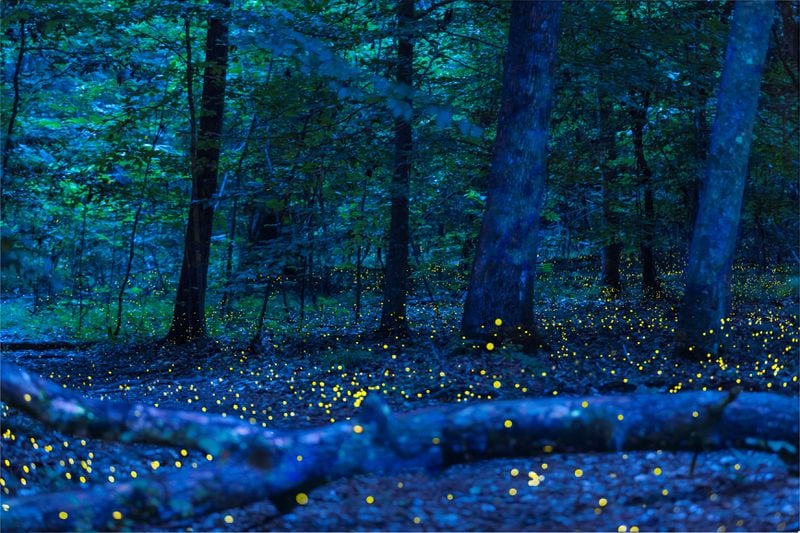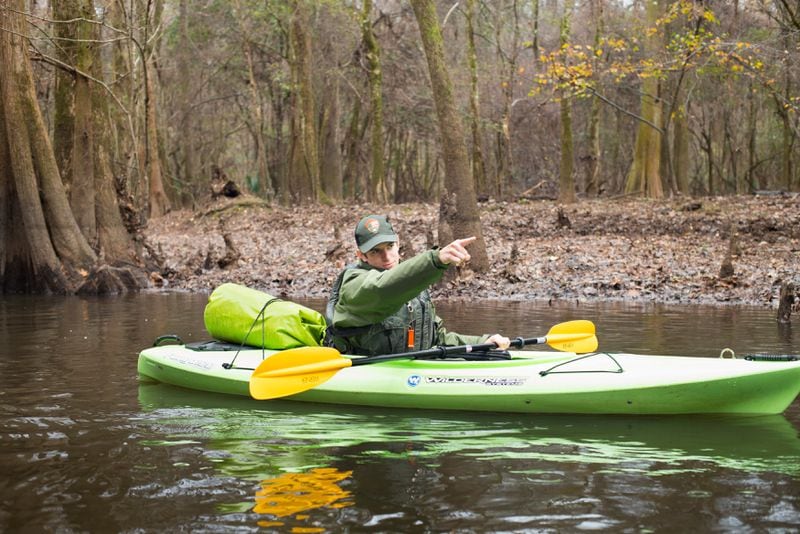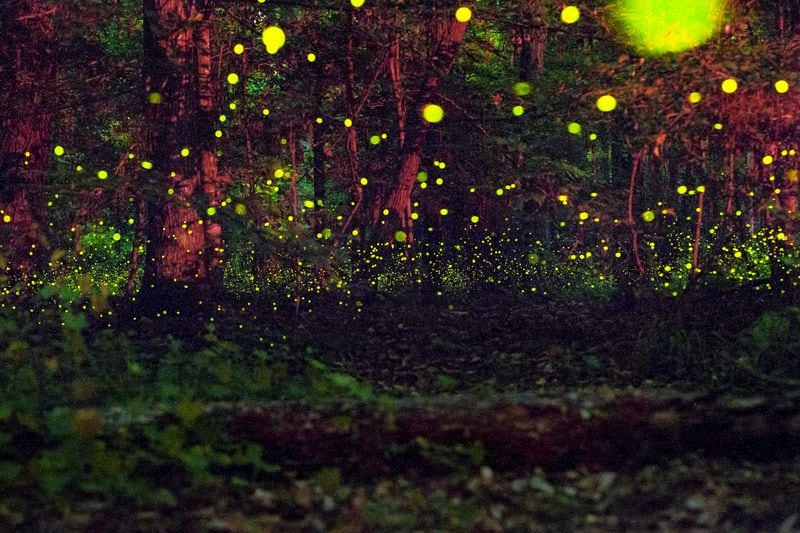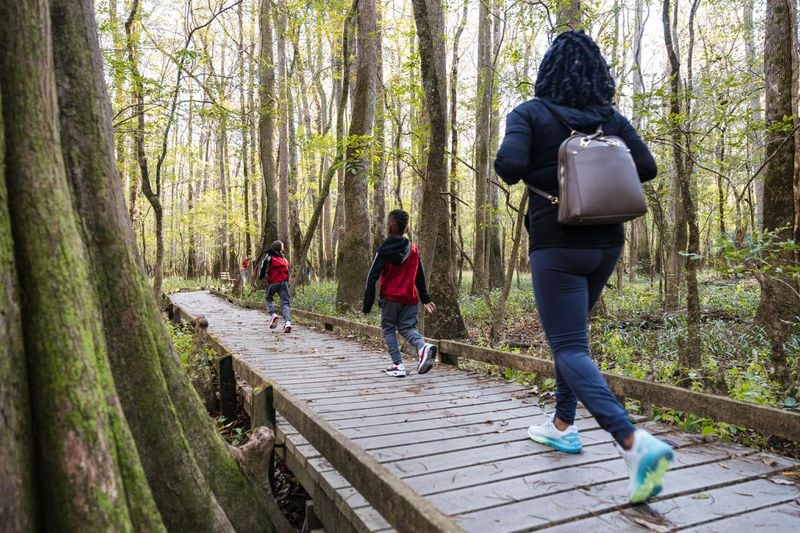Atlanta Journal Constitution. May 2022. Sunday print.
On a humid summer evening, the thick temperate deciduous forest is hauntingly dark. As soon as the last twilight of dusk disappears, you begin to see sparkling dots emerge from the canopies. As your eyes adjust to the darkness, more and more flashing lights become visible. Soon, there is a carpet of magical synchronized firefly display – a rare phenomenon that occurs very few places in the world.

You may have seen fireflies in your backyard, but only a lucky few have had the opportunity to witness thousands of fireflies at one time, blinking together in unison. The number of people who have been privy to the natural light show is growing, though, thanks to two park programs within driving distance of Atlanta.
There are more than 2,000 firefly species in the world, but only three of the synchronized flashing varieties are found in North America. In the Southeast, there are two national parks – Congaree National Park in South Carolina and the Great Smoky Mountains National Park in Tennessee — where the public is invited to witness the spectacle.
But first, why exactly do fireflies light up?

Credit: Brett Flashnick
When fireflies or lightning bugs (which are actually beetles) mature to adult age, they perform a mating ritual that involves blinking to attract partners. Males hover two to four feet above the ground, while females remain stationery closer to the ground’s leaf litter. The fireflies communicate by flashing their light in what’s called “photic dialogue.” Each firefly species has a distinctive flash pattern, like their own distinct language. And when synchronous fireflies achieve a swarm, they naturally sync their blinks.
Tale of two parks
The site of a UNESCO biosphere reserve, Congaree National Park encompasses 26,276 acres in central South Carolina, 18 miles southeast of the state capital, Columbia. Commonly referred to as a swamp, the park’s ecosystem contains old growth forests, champion trees (the largest tree specimens found in the U.S.), as well as bobcats, alligators and turtles. There are more than 25 miles of trails and 2.4 miles of boardwalk for hiking and birdwatching. Canoeing and kayaking on the Congaree River are popular pastimes.
“When I got to Congaree, the firefly synchronization was a relatively unknown phenomenon in this area,” says Jonathan Manchester, park ranger and volunteer program manager at Congaree National Park since 2014. Once the park started a viewing event in summer 2017, crowds kept getting bigger with each passing year. In 2019, more than 12,000 people visited during the two-week Firefly Viewing Experience.

Credit: James Tarpley
Because of its remote location at the edge of a flood plain that lends itself to a chemical-free, moist habitat with limited light pollution, Congaree is one of the best places to see synchronous fireflies in the Southeast. While there are ample firefly populations in the park throughout the year, the Photuris frontalis species has a unique speed and rhythm pattern. Males put up a synchronized display emitting quick, single flashes twice per second, courting the females each night for roughly two weeks during summer. During this time, spectators with passes can drive up to the Harry Hampton Visitor Center, walk a short distance into the woods and watch the action.
For overnight accommodations, Longleaf and Bluff campgrounds inside the park provide sites for tent and hammock camping only. Sites are $10 per night, $20 for groups, and require advance reservations online at www.recreation.gov or by calling 877-444-6777. For a more luxurious overnight experience, head to Hotel Trundle ($204 a night, 1224 Taylor St. 803-722-5000, www.hoteltrundle.com), a historic boutique hotel in downtown Columbia.
Containing 70 miles of the Appalachian Trail, the Great Smoky Mountains National Park boasts 850 miles of trails and unpaved roads, as well as unique natural attractions such as Alum Cave Bluffs and Arch Rock. Because of its many scenic overlooks, the park is ideal for a driving tour. But those seeking adventure can go hiking, fishing, horseback riding, bicycling, water tubing and backcountry camping.
Of the 19 species of fireflies found in the Smokies, the only one that synchronizes is Photinus carolinus. The synchronized flashes of this species take place in bursts of five to eight yellow blinks, followed by eight to 10 seconds of darkness. While it may appear that the chatter is continuous, fireflies drop in and out of conversations. To view the phenomenon, visitors must park at the Sugarlands Visitor Center, eight miles from Gatlinburg, Tennessee, and take a shuttle to the Elkmont campground area to view the phenomenon.
The Elkmont Campground has 200 tent and RV sites, although there are no hookups for water, power or electricity. Cost is $25-$27 per night. For reservations, go to www.recreation.gov or call 877-444-6777. For more modern conveniences there are dozens of hotels in nearby Gatlinburg.

Credit: Brett Flashnick
Preparing for your visit
Synchronous firefly events typically occur over a two-week period between late May to early June. Actual dates are dependent upon environmental factors such as temperature and soil moisture. However, researchers work with park officials to release predicted viewing dates in late April, so you can plan your visit accordingly.
Over the years, parks have taken measures to restrict entry to a limited number of people to lessen the impact on the fireflies. Congaree holds an annual lottery permitting 120 cars into the park each night during its six-night event.
The Great Smoky Mountain National Park offers 100 advance parking passes per day, for each of the eight evenings on a first-come, first-served basis. The lottery dates and event dates are announced in late April and tickets generally sell out quickly.
If you don’t win the lottery, a few private outfitters, including Cataloochee Valley Tours, offer private guided experiences at “secret locations” in and around the park and at nearby Norton Creek Preserve. These events are sometimes supplemented by food and drink, costing anywhere from $75 to $500 per person.
To fully enjoy firefly viewing, you must be in complete darkness. Any kind of light inhibits the fireflies’ ability to communicate.
“It is like trying to talk in a noisy room,” says Manchester, who recommends covering flash lights with red or blue cellphone. Light pollution and use of insecticides such as mosquito spray are two reasons for decline in firefly populations in urban backyards.
“The most important thing to know when you are here, is to not disturb the firefly habitats. That means no large crowds, use of flashlights or camera lights,” advises Manchester.
Smart phone cameras will not capture fireflies, so it’s best to keep them away, as they emit light. If you want to take photographs of the firefly synchronization, make sure to bring a tripod and a powerful camera that allows for long exposures and high ISO settings. You will need to sit still in a dark place to capture them and edit a series of photos into a stacked image to get the numbers you see in real life.

Credit: Forrest Clonts
The rangers at the Great Smoky Mountains National Park recommend arriving early to get situated, keeping in mind the synchronization activity peaks between 9-10 p.m. They recommend bringing a small camping chair or a blanket to sit on. To avoid bug bites, wear long sleeves and pants made of breathable fabrics instead of mosquito repellants, which deter fireflies. Note that flashing may be diminished on cool and misty nights.
Due to the pandemic, public viewing of the fireflies was restricted in 2020, but that has had a positive impact on the insects’ reproduction cycle, allowing the firefly populations to grow.
“Fireflies mature on a two-year cycle, so the fireflies we will see this year are the product of summer 2020,” said Manchester.
If you want to witness something good that came out of 2020, get your tickets early to experience a rare and magical event.
IF YOU GO
Congaree Fireflies Experience. $20 per vehicle, standard passenger, two-axle vehicles only. Congaree National Park, 100 National Park Road, Hopkins, South Carolina. 803-776-4396, www.nps.gov/cong/fireflies.htm
The Great Smoky Mountains Firefly Viewing Lottery. $25 per vehicle, seven-passenger limit. $2 shuttle fee, per person. Sugarlands Visitor Center, 1420 Fighting Creek Gap Road, Gatlinburg, Tennessee. 865-436-1261, www.recreation.gov/ticket/facility/233374
Cataloochee Valley Tours. Private firefly walks May 23-June 6. $175 per person (sold out). Add your name to the wait list, or mark your calendar to register in March 2023. cataloocheevalleytours.com/firefly-night-walks.html
Click here to continue reading on AJC.com…